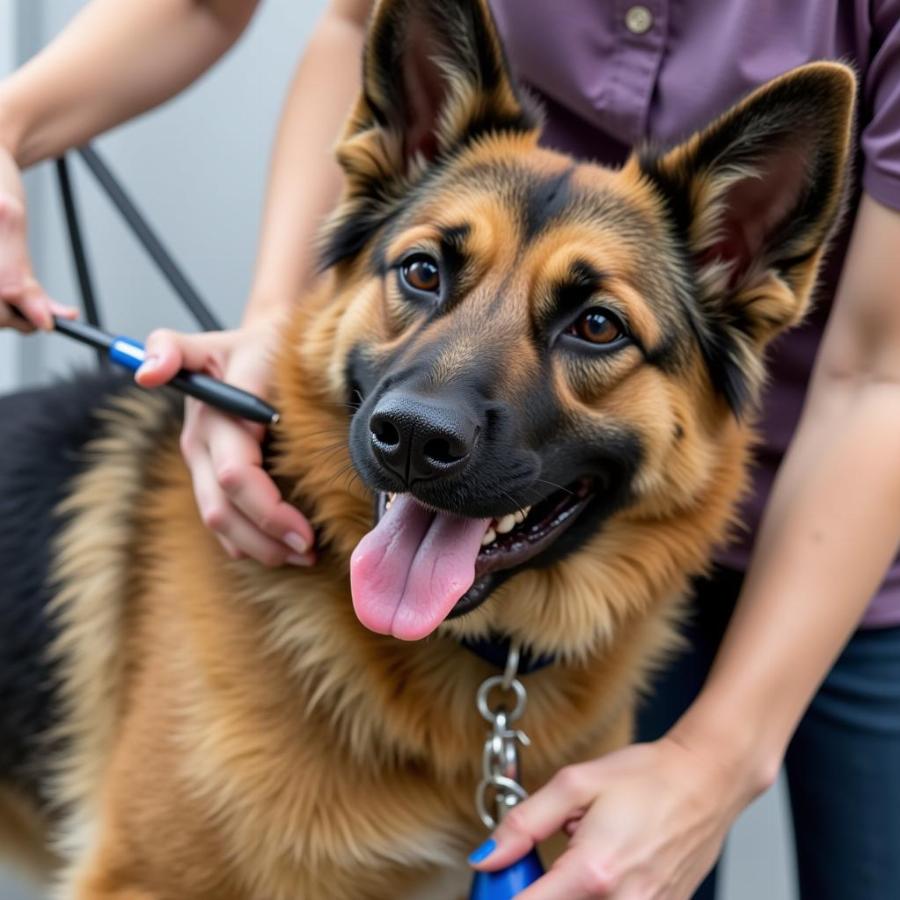The Australian Cattle Dog and German Shepherd mix, often called the Heeler Shepherd, is a fascinating blend of two intelligent and energetic breeds. This guide dives deep into what you can expect from an Australian Cattle Dog and German Shepherd mix, covering everything from temperament and training to health and grooming. Are you considering welcoming this dynamic duo into your life? Read on to discover if this mix is the right fit for you.
Understanding the Heeler Shepherd: Temperament and Traits
The Australian Cattle Dog, nicknamed the “Heeler,” is known for its herding instincts, boundless energy, and intelligence. The German Shepherd, renowned for its loyalty, protective nature, and trainability, contributes equally strong characteristics. Combining these two breeds results in a dog that is both highly intelligent and intensely loyal. Expect a Heeler Shepherd to be protective of its family and wary of strangers, a trait inherited from the German Shepherd. However, early socialization is crucial to ensure they develop into well-adjusted adults. This mix thrives on activity and requires a significant amount of physical and mental stimulation. They aren’t suited for apartment living and do best in homes with large yards where they can run and play.
Training Your Australian Cattle Dog and German Shepherd Mix
Training a Heeler Shepherd can be both rewarding and challenging. Their intelligence makes them quick learners, but their independent nature requires a firm and consistent approach. Positive reinforcement methods work best, focusing on rewards and praise. Early obedience training is essential to establish clear boundaries and prevent behavioral issues. Because of their herding instincts, they may nip at heels, especially children, so training should address this early on. Consistency and patience are key to successfully training this intelligent mix.
Socialization is Key
Early socialization is paramount for a well-balanced cattle dog and german shepherd mix. Exposing them to various people, animals, and environments from a young age helps them become confident and adaptable adults.
Health and Grooming: Caring for Your Heeler Shepherd
This mix is generally healthy but can inherit health issues common to both parent breeds, such as hip and elbow dysplasia, progressive retinal atrophy, and bloat. Regular veterinary checkups are essential to catch any potential problems early.
Grooming Needs
 Chải lông cho chó lai Australian Cattle Dog và German Shepherd
Chải lông cho chó lai Australian Cattle Dog và German Shepherd
The Heeler Shepherd typically has a double coat that sheds moderately. Regular brushing, especially during shedding season, is necessary to keep their coat healthy and prevent matting. Occasional baths are sufficient.
Is a Heeler Shepherd Right for You?
This energetic and intelligent mix is a wonderful companion for active individuals or families who can provide them with the physical and mental stimulation they need. They thrive in homes with large yards and enjoy activities like hiking, running, and playing fetch. If you’re looking for a loyal and devoted companion who will keep you on your toes, the Australian Cattle Dog and German Shepherd mix might be the perfect fit.
Conclusion
The Australian Cattle Dog and German Shepherd mix is a unique blend of intelligence, loyalty, and energy. While they can be a challenging breed to train, their devotion and playful nature make them rewarding companions for the right owner. With proper training, socialization, and care, a Heeler Shepherd can bring years of joy and companionship to your life.
FAQ
- Are Australian Cattle Dog and German Shepherd mixes good with children? With proper socialization and training, they can be good with children, but supervision is always recommended due to their herding instincts.
- How much exercise does a Heeler Shepherd need? They require a significant amount of exercise, both physical and mental, ideally at least an hour a day.
- Are they good apartment dogs? No, they are not well-suited for apartment living and do best in homes with large yards.
- Do they bark a lot? They can be prone to barking, especially if not properly trained or stimulated.
- How long do they live? Their lifespan is typically 10-13 years.
- Are they easy to train? They are intelligent but can be independent, requiring a firm and consistent training approach.
- What kind of grooming do they need? They require regular brushing, especially during shedding season.
Related Articles
Beaut Dogs is your trusted source for all things related to dog breeds, offering comprehensive and expert guidance on dog care. For personalized advice on the most loyal dog breeds, email us at [email protected]. We’re here to help you navigate the world of canine companionship.